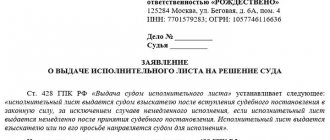After the court has considered the case and made a decision in favor of the plaintiff, the plaintiff can receive a writ of execution. In order to receive a writ of execution, you must make sure that the deadline for appeal has expired or the defendant’s appeal has been denied, and contact the court that made the decision. You can go to court and obtain a document in the following ways:
- Personal application to the court office to submit an application for the issuance of a writ of execution. In this case, you will be able to receive the document in at least 2 weeks, but sometimes the receiving process is delayed for a month or more - unfortunately, the court office often delays the process of issuing the sheet or sending it to the bailiffs.
- Send an application for the issuance of a document by mail with the note sheet also sent to the plaintiff by post.
- Do not receive the sheet yourself, but ask in the application to send the sheet directly to the bailiffs.
a sample application for the issuance of a writ of execution from the link: application for the issuance of IL.rtf
Deadlines for applying for a writ of execution
The law does not provide for a time limit for receiving a writ of execution by the plaintiff: you can apply the next day after the decision comes into force, or a month or two later - but the date of commencement of enforcement proceedings by bailiffs depends on this.
In cases where a writ of execution is needed urgently, the application should be written as early as possible and submitted on the day the court decision comes into force. Also, to speed up the process, you can regularly call the office and ask if the document is ready.
Sample complaint about red tape when issuing a writ of execution
It should be remembered that the office has no reason to delay the issuance of the document too much (more than 30 days). If you think that the office is deliberately delaying the issuance process, you should write a complaint to the chairman of the court about the red tape when issuing the writ of execution.
Consequences for the debtor after the initiation of enforcement proceedings
Initiation of enforcement proceedings entails the following consequences for the debtor:
- receipt of regular reminders and notifications from bailiffs,
- withholding the amount of debt from wages and other types of financial receipts,
- foreclosure of property (real estate, vehicles, other valuables),
- placing intentionally hidden assets on the executive wanted list,
- seizure of property, as a result of which the debtor will not be able to dispose of it (sell, donate, etc.),
- imposing temporary restrictions on the debtor’s travel outside the Russian Federation,
- temporary ban on driving a vehicle.
A complete list of measures for compulsory execution of obligations provided for in the IL is contained in Chapter. 7 of the Law of the Russian Federation No. 229-FZ.
What should a debtor do after initiating an IP?
If the procedure for forced collection of debt is initiated by FSSP employees, the debtor must act as follows:
- interact with the bailiff in every possible way and do not try to hide,
- make every effort to pay off the existing debt,
- if there is no financial opportunity to repay the debt, then you can apply to the court for a deferment or installment plan,
- You can also make attempts to peacefully resolve the issue with the creditor. In this case, you should insist that the latter take the writ of execution from the FSSP.
How to submit a writ of execution to bailiffs?
What to do with the writ of execution after receiving it in person or by mail? Then it must be submitted for execution to the bailiffs if your debtor does not intend to pay voluntarily, and execution through the bank or through the debtor’s work is either impossible or did not bring results.
All enforcement actions are carried out at the place of residence or stay of the debtor citizen, the legal address of the organization or its branch, representative office, or at the location of the debtor’s property. If a writ of execution is issued to perform certain actions, it is executed at the place where these actions were performed. Once you know the debtor's address, you can determine which department of bailiffs you need to submit the writ of execution to.
You will leave the original document at the bailiff department, so we recommend making several copies and a scanned copy.
Cases when you do not need to contact bailiffs:
- your debtor is an organization excluded from the Unified State Register of Legal Entities;
- the debtor is declared bankrupt;
- the statute of limitations for execution of the judicial act has expired (3 years), and you do not have a court ruling to restore this period;
- your debtor is a budget organization or the budget or treasury of the Russian Federation.
Sample application when submitting a writ of execution
When submitting a writ of execution, bailiffs must have a package of documents with them:
- application for execution - 2 copies when submitted in person, 1 copy when sent by mail. The application is signed personally by the claimant, the director of the company or a representative by proxy;
- original writ of execution;
- copy of passport (1 page and registration), bank account details - if you are a citizen;
- representative's power of attorney - if the application for execution will be signed by someone else for you;
- copies of documents confirming that the debtor has any property, his place of work, information about his property status, etc. - if there is. An extract from the Unified State Register of Legal Entities can be attached to the debtor organization or individual entrepreneur.
There are two ways to submit a package of documents:
- in person - hand over the mark on your copy of the application;
- sending by mail - send by a valuable letter with a list of the contents and a notification of delivery. Save the postal receipt and a list of the contents with a postmark.
Ready! Next, the application and writ of execution will go to a specific bailiff, and he will open enforcement proceedings or issue a ruling refusing to initiate enforcement proceedings. Read more about this in the article “How do bailiffs collect?”.
What can be recovered from a debtor through bailiffs?
If the debtor does not have the financial ability to repay his obligations, then foreclosure may be applied to his property (cars, apartments, luxury items, etc.).
Apartment and other real estate
As part of enforcement proceedings, foreclosure may be applied to the debtor's real estate. It could be:
- apartment,
- land plot,
- Vacation home,
- office space,
- country house,
- garage, etc.
ATTENTION. To foreclose on real estate, two conditions must be met: this object must not be the debtor’s only home, the apartment (house, office, etc.) must belong to the defendant by right of ownership.
Automobile
If the debtor owns a car, then foreclosure can be applied to this type of property.
In this case, the car will be sold, and the proceeds will be used to pay off the debt.
It is worth mentioning separately that if the debtor is disabled and he needs a car to move, then it will not be possible to foreclose on this type of property. This conclusion follows from Part 9, Clause 1, Art. 446 Code of Civil Procedure of the Russian Federation.
Seizure and collection of property from the debtor's apartment
In addition to real estate and vehicles, foreclosure may also be applied to other types of property of the debtor. For example:
- valuable paintings,
- antiques,
- jewelry,
- Appliances,
- individual interior items of a certain value, etc.
The debtor is hiding property - what can be done
Sometimes collectors are faced with situations where, in order to avoid collection, debtors hide their property (re-register it to relatives, transport it to another place, etc.).
What can you do in this situation:
- apply for seizure of the relevant property,
- try to challenge suspicious transactions in court,
- request information about the availability of assets owned by the debtor (for example, contact Rosreestr),
- missing property can be put on the executive wanted list according to the procedure described in Art. 65 of the Law of the Russian Federation No. 229-FZ.
In what cases is it necessary?
If the court applied the claim procedure, then the logical conclusion of the process will be a decision. There is another judicial procedure, it is called a writ. Its distinctive feature is that the application is considered within several days. In this case, participants in the process are not invited to participate in the meeting.
Based on the results of the consideration, the magistrate (it is within his competence to issue court orders) will draw up the necessary document, and then send it to interested parties.
The court order immediately acquires the force of an executive document. Accordingly, there is no need to go with him to receive the document in question. It is precisely one order that should be submitted to the FSSP.
The procedure for issuing the sheet
According to the rules defined by law, a writ of execution is drawn up and issued by the body that examined the case regarding the filed claim. The extradition is carried out on the same day when, from a legal point of view, a certain outcome of the court case becomes relevant.
However, it also happens that the transfer of the required paper is carried out immediately at the moment a unit of the judicial system makes a final decision on your case.
The plaintiff has the right to demand the issuance of a writ of execution directly to him
According to the letter of the law, there are only two options regarding who will be issued the required sheet.
- In the first case, the writ of execution is handed directly into the hands of the plaintiff who filed an application to initiate proceedings in a specific case.
- In the second, the document from the court is redirected to the Federal Bailiff Service, whose representatives subsequently monitor the fulfillment of the requirements stated in the document.
Is there a statute of limitations for a writ of execution?
Debtors are also interested in this because they believe that after a certain time their debts will expire and the bailiff will be forced to close the case.
Example
I am aware that there is a statute of limitations. The bank collected 250,000 rubles from me four years ago. I don’t have much money or property. I paid a tenth of the required amount more than three years ago. Since then I have been working unofficially, so the bailiff cannot collect anything. I do not have any real estate or vehicles. After what time does a writ of execution lose its force, does it have a statute of limitations, asks credit debtor Alexey.
Very often people get confused in concepts. The above example is a typical case of such a misconception. The statute of limitations mentioned by the citizen in the example has nothing to do with enforcement cases.
This term refers to cases where plaintiffs bring their claims to court. If three years have passed, the claim is denied. In the above example, the claim was filed a very long time ago. If the dispute is considered by the court and a decision is made, it means that the plaintiff met the deadline specified by law.
Once the case was initiated, the deadline for submission and/or collection notice was met. Consequently, the credit debtor will ultimately have to answer for his financial obligations to the bank.
In what cases do bailiffs have no right to collect a debt?
The law provides for several special cases, in the event of which the collection of debt under a writ of execution is prohibited, even if the money has not been returned. Let's talk about them in more detail.
- Debt to the tax office. If arrears (penalties, fines) accrued by the Federal Tax Service are considered hopeless, they must be written off according to Art. 59 of the Tax Code of the Russian Federation, and the collection of money from the debtor has been stopped.
The tax office can write off the debt of individuals in the following cases:
- The bailiff service returned the writ of execution to the plaintiff due to the absence of the defendant or his property that could cover the debts.
- Five years have passed since the debt arose, and this amount is not enough to carry out the bankruptcy procedure (RUB 500,000 or more).
- The court did not accept the petition to declare the debtor bankrupt and refused to initiate a case, since the applicant is not able to pay for all the procedures.
- The defendant was declared insolvent in the bankruptcy case.
- Administrative penalty . All administrative sanctions must be fulfilled within 2 years from the beginning of the decision on their imposition. After this period, debt collection under a writ of execution or other punishments are prohibited in accordance with the provisions of the Code of the Russian Federation on Administrative Offences. And anyone who deliberately delays time and evades paying the fine will not be among the “lucky ones”, even if 2 years pass. The deadline will be temporarily delayed until the obstacles in debt collection are finally eliminated.
- "Not all at once" . In cases where the defendant has nothing but wages (pensions), the bailiff applies regular deductions from these incomes. The law does not allow deducting more than 50% of available income. The exception is overdue alimony and compensation for harm to health (life), where permissible deductions reach 70%. That is, for citizens from whom the maximum share of the mentioned income is already withheld, collection of other debts is impossible. The exception is a mortgage, where it is possible to sell the apartment to pay off the arrears.
How to present a document to the bailiff?
Everyone knows that you need to take the document to the bailiff department. However, you should know that the case can only be opened at the debtor’s place of residence. As a rule, this place is determined based on the registration data of the debtor citizen.
One sheet is not enough. The law obliges the claimant to submit a statement along with this document. There are also no requirements for its preparation. You just need to indicate:
- sheet details,
- what court released him
- bank details for money transfers
- a request to the bailiff to initiate a case
Within three days of such an application being received, it will be transferred to the bailiff for work. The bailiff, having examined the submitted documentation, must again decide within three days whether to initiate a case or refuse.
If everything is in order with the documents, the deadline for presentation has not expired, then a positive decision will definitely be made. It takes the form of a resolution. The document itself goes into the case, and its copies are sent to the debtor and the person who demands execution of the court decision.
How to accept and register
If the theater, as we know, begins with a hanger, then work with the executive document begins with its reception and registration. Let's dwell on this in more detail. Most often, a company receives writs of execution addressed to its employees (for the payment of alimony, administrative fines, etc.), for the execution of which the employer must make deductions from their wages. Much less often, an organization receives writs of execution addressed to itself - their “working out” is usually first dealt with by the legal service, which conducts litigation. After all, in ordinary language, a writ of execution is the result of a case lost in court. The writ of execution is issued by the court after the judicial act enters into legal force.
note
Such a safety net is quite justified, since recently various types of scammers have become noticeably more active, stealing funds from the bank accounts of legal entities with the help of writs of execution issued by the courts. Large companies whose accounts are opened in large banks are chosen as victims. After all, the large volume of transactions both in the company and in the bank makes it difficult to promptly track illegal withdrawals of funds from bank accounts.
What to do if a complaint is filed?
Within the above period, a citizen or organization, if they have lost the case, can file a complaint. If you miss it, the submitted complaint will not be accepted by a higher court. If the other party wants to restore the deadline, then it will have to submit a written request along with the complaint.
The party that won the case will be asked by the court to submit its objections to the complaint. It is not necessary to do this; the law does not impose such an obligation on the participant in the process.
But if there is a desire to object to the arguments set out in the complaint, it makes sense to do so. There are no special requirements for the preparation of such a document. This means that it is compiled in any form. It is enough to familiarize yourself with the appeal and indicate which arguments of the opposing party should not be taken into account by the court.
The higher court has two options:
- Refuse the applicant and leave everything in effect
- Recognize the complaint as justified, cancel the decision and make a new one.
The verdict of the appellate court is formed in the form of a ruling, and it immediately becomes binding. If the initial decision here stands, or, as lawyers say, “is overpowered,” then you can receive the long-awaited document.
What deadlines must be met?
There is a general deadline for presenting documents to the bailiff. It is three years. Slightly different requirements are established for documents on the collection of regular payments. A typical example is a court order or decision to collect money for child support.
Holders of the writ of execution do not need to comply with any three-year period. They have the right to submit documents to the FSSP at any time until the child reaches full adulthood. And even when he becomes such, he is given three more years to file for collection of payments.
It happens that claimants miss deadlines, as a result of which the writ of execution loses its force. Most often this happens for some very good reason. If she is truly respectful, then you can ask the court to restore the terms. The request must be presented in the form of an appropriate written petition.
Deadline for debt collection through the FSSP
After the opening of production, the bailiff gets exactly 2 months to achieve a certain result. But in practice this period is much longer. The following factors are taken into account:
- waiting for a response from the debtor;
- conducting searches for property or the person himself;
- suspension during the case;
- terms of property sale. There are other issues that delay the deadline.
The maximum production period is 3 years. The debt does not disappear anywhere - after six months, the creditor can again initiate the debt collection procedure using a court order.
Is it possible to get a duplicate if a previously received original sheet is lost?
Let's imagine that you received a writ of execution in your hands, but due to a fatal accident, you lost or damaged it. If you think that in this case you will be denied the legal rights that the document you are seeking gives you, you are mistaken.
To be able to document your requirements, contact the court to issue a duplicate. In this situation, the application also occurs in an official format; the document is issued on the basis of an application drawn up in the same form as the application for the original. The only difference between the repeated application and the initial one will be that the request is somewhat modified and now you are requesting the issuance of a duplicate of the original document to replace the old copy that you lost.
In addition, you need to do the following:
- additionally describe the circumstances under which the document was lost by you;
- attach evidence, if any;
- indicate in writing a list of all documents attached to the application as evidence of the loss that occurred.
We would like to draw your attention to the following fact: the statement of loss and request to issue a duplicate of the writ of execution submitted by you will be considered by an unauthorized employee of the structure. An entire court hearing is initiated aimed at establishing the truth of the facts you presented that influenced the loss of the previous document. Provided that the court finds everything that you have said realistic, it will grant your request for a copy of the writ of execution.
Application for issuance of a duplicate writ of execution
The re-issued form is filled out in the same way as the first one, and its legal force is also equal to that of the original document.
Let's sum it up
Not every person is able to independently answer the question “I have a writ of execution in hand, what to do next.” Please read the information provided in this material carefully and follow it so that you complete the entire process as quickly and efficiently as possible. The main thing to remember is that enforcement proceedings are a serious matter. Don’t force events aggressively, influence them gradually, and everything will work out.
Sometimes going to court is the only chance to get back the funds you are entitled to.











